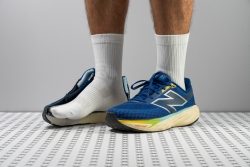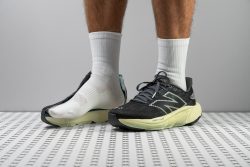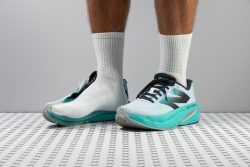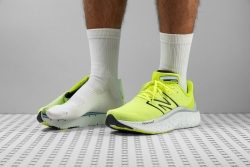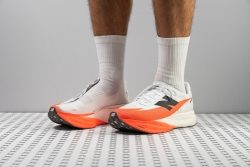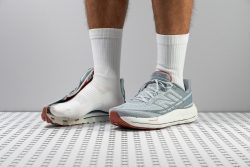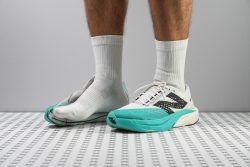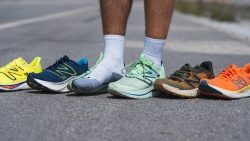7 Best Cushioned New Balance Running Shoes in 2025

We buy shoes ourselves. We earn commissions when you buy through us, at no extra cost. Why trust us
New Balance running shoes are known for their cushioning and sometimes odd-looking midsoles. Looking for good cushioning means understanding and covering different features, and we're here to tell you all about them, from how they feel on the runs to how they compare to other shoes, thanks to our lab data.
In case you want your answer ASAP, look at our top picks that we proudly showcase here in different categories. For curious runners, we elaborate on every single detail in the guide section.
How we test cushioned New Balance running shoes
Our approach to testing running shoes consists of a) test runs and b) lab tests. This allows us to objectively overview running shoes. Test runs allow us to pay attention to the smallest details that maybe even lab tests can't cover, while lab data allows us to quantitatively describe the performance of the shoe and compare it to the other shoes.
Thanks to our lab tests, we end up with more than 20 data points, such as shock absorption and energy return. These help compare the shoes and put each shoe into a context.
After we're done with both field and lab tests, we pick the very few best performers in different categories.
Best cushioned New Balance running shoes overall
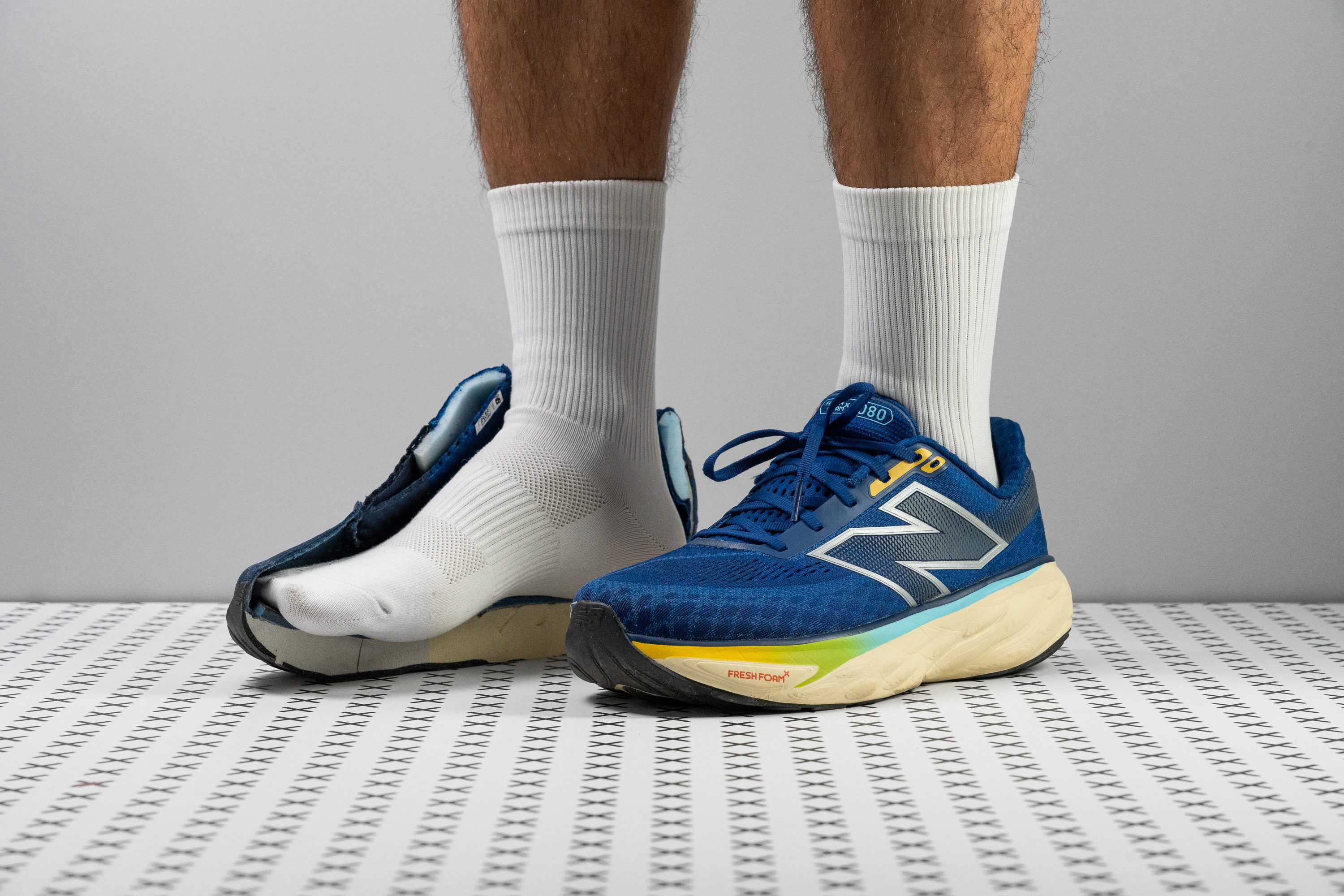


















































What makes it the best?
Countless miles of pounding the pavement and many hours spent in the lab verify the Fresh Foam X 1080 v14’s status as the best overall New Balance cushioned running shoe. From its plush touch to its natural feel, and its free-flowing ventilation, this shoe puts comfort at the forefront.
The stack closes its way to being a maximalist with its tall 37.0/32.8 mm stack. What makes its cushioning truly special is its gentle persona, shown by our durometer with a low 11.9 HA reading, 43.3% softer than average. It's highly comfortable even on days we want to run longer.
Despite its height, the 1080 v14 didn't restrict our movement and got a near-average rating in our flexibility test.
Embracing our foot from the top is a plush triple-layer jacquard mesh upper that surprisingly feels refreshing. While most uppers of this material tend to run warm, the 1080 v14 stands out with a 4/5 breathability rating in our lab.
Since this shoe is all about comfort, we think it shines best on recovery and relaxed days. Those who crave responsiveness will find its ride underwhelming especially with its heavy 10.1 oz (285g) build.
Pros
- Amazing step-in feel
- Excellent durability
- Cloud-soft midsole
- Ideal for forefoot and midfoot strikers
- Perfect for recovery runs
- Airy upper
- Fairly priced for a premium daily trainer
- Stability improvements
Cons
- Noticeable weight increase
- Tapered toebox limits toe splay
- Midsole could be too soft for some
- Lacks energy return
Cushioned New Balance running shoes with the best shock absorption
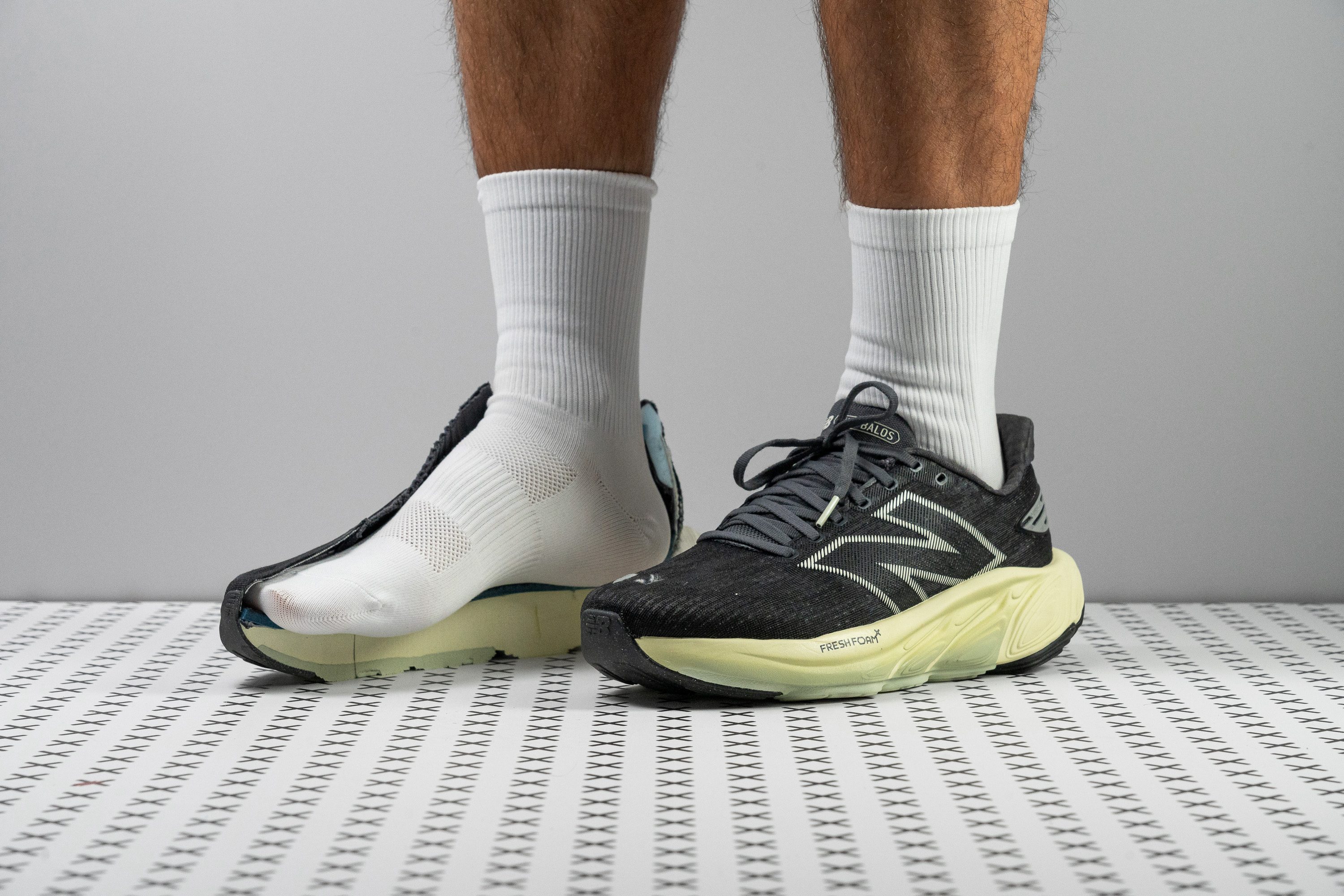




















































What makes it the best?
The Fresh Foam X Balos takes comfort to the next level by blending staggering heights with ultra-plushness. Our lab affirms its status as the best shock-absorbing New Balance cushioned running shoe not only because of its generous foam but also because of its unexpected light and forgiving ride.
Balos features a towering 37.8/31.9 mm stack, which is a huge buffer between our feet and the ground! On top of that, its foam composition offers otherworldly impact protection, enhancing comfort and muscle protection for easy days. In our shock absorption test, it returned with top-level scores of 158 SA and 129 SA in the heel and forefoot, respectively.
Despite its thickness, it offers unexpected flexibility for bending our feet. In our 30-degree test, it emerged 15.3% more malleable than average, enhancing its natural feel.
Another surprise is its low weight of 8.7 oz (247g). Being 6.8% lighter than average, it helps prevent fatigue, especially in the latter miles of our runs.
While its toebox offers good horizontal room, its vertical space is limited to 24.5 mm. We warn runners with high-volume feet to approach this pair with caution.
Pros
- Plush, cloud-like cushioning
- Amazing rockered geometry
- Lightweight for its size
- Breathable, moisture-wicking upper
- Ideal for long runs and recovery days
- Works for walking if needed
- Fantastic knit tongue
- Superb for midfoot strikers
- 360-degree reflectivity
- 360-degree reflectivity
Cons
- Low-volume toebox
- Price feels a bit excessive
- Not enough energy return
- EVA outsole raises durability concerns
Best cushioned New Balance running shoes for tempo training
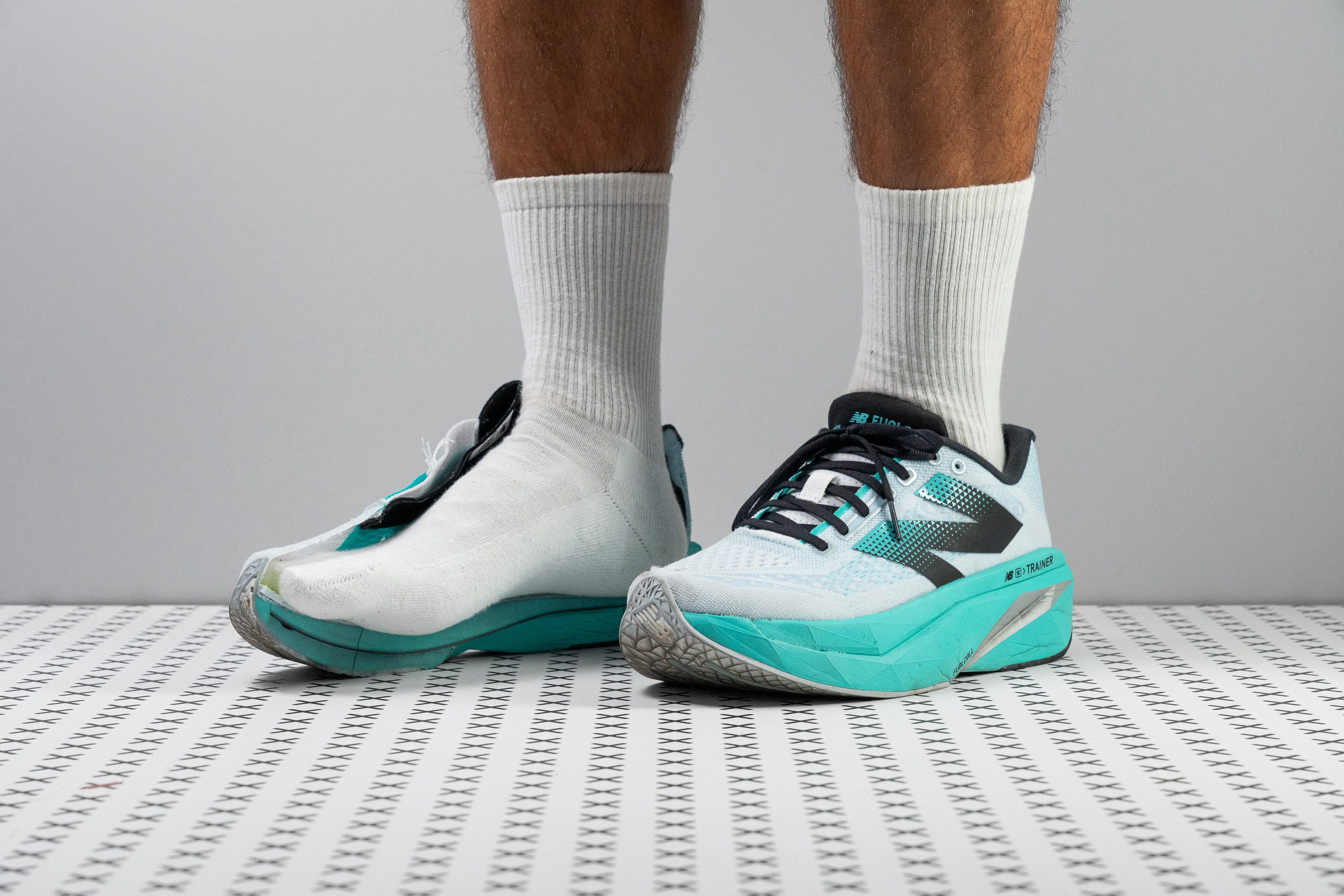


























































What makes it the best?
Through extensive runs and in-depth lab tests, we selected the FuelCell SuperComp Trainer v3 as the best New Balance cushioned running shoe for tempo runs. It delivers highly energetic takeoffs and balances them with cushioned and stable landings. It’s speedy without being too aggressive, making it the perfect trainer.
SC Trainer v3’s source of power lies in its full-length Energy Arc carbon plate, which includes a void in the middle to make room for easier movement. Putting it to our bend test reveals a stiffness score of only 18.7% above average, while racers tend to score much higher.
This shoe proves that fast shoes can be comfortable, featuring an above-average stack that’s ultra-plush to the touch. Our durometer confirms the delightful FuelCell foam is 57.9% softer than average, making long miles more bearable.
Despite its cloudlike cushioning, the SC Trainer v3 feels amazingly stable due to non-intrusive features like the broad sole flare, midsole sidewalls, and expansive midfoot. Our calliper measurement confirms this with a 117.7 mm figure vs. the 114.1 mm average.
In this age of lighter shoes, the SC Trainer v3 felt cumbersome due to its weight, and our scales agree with a 9.8 oz (278g) result. More agile options are available in the market.
Pros
- Reasonably priced
- Ultra-soft, responsive midsole
- Includes a carbon plate
- Ideal for marathon training
- Great stability
- Premium upper delivers great fit
- Fantastic for midfoot strikers
- Solid traction
Cons
- Increased weight
- Still not 100% PEBA foam
- Midsole groove traps pebbles
- Upper durability
Best budget cushioned New Balance running shoes
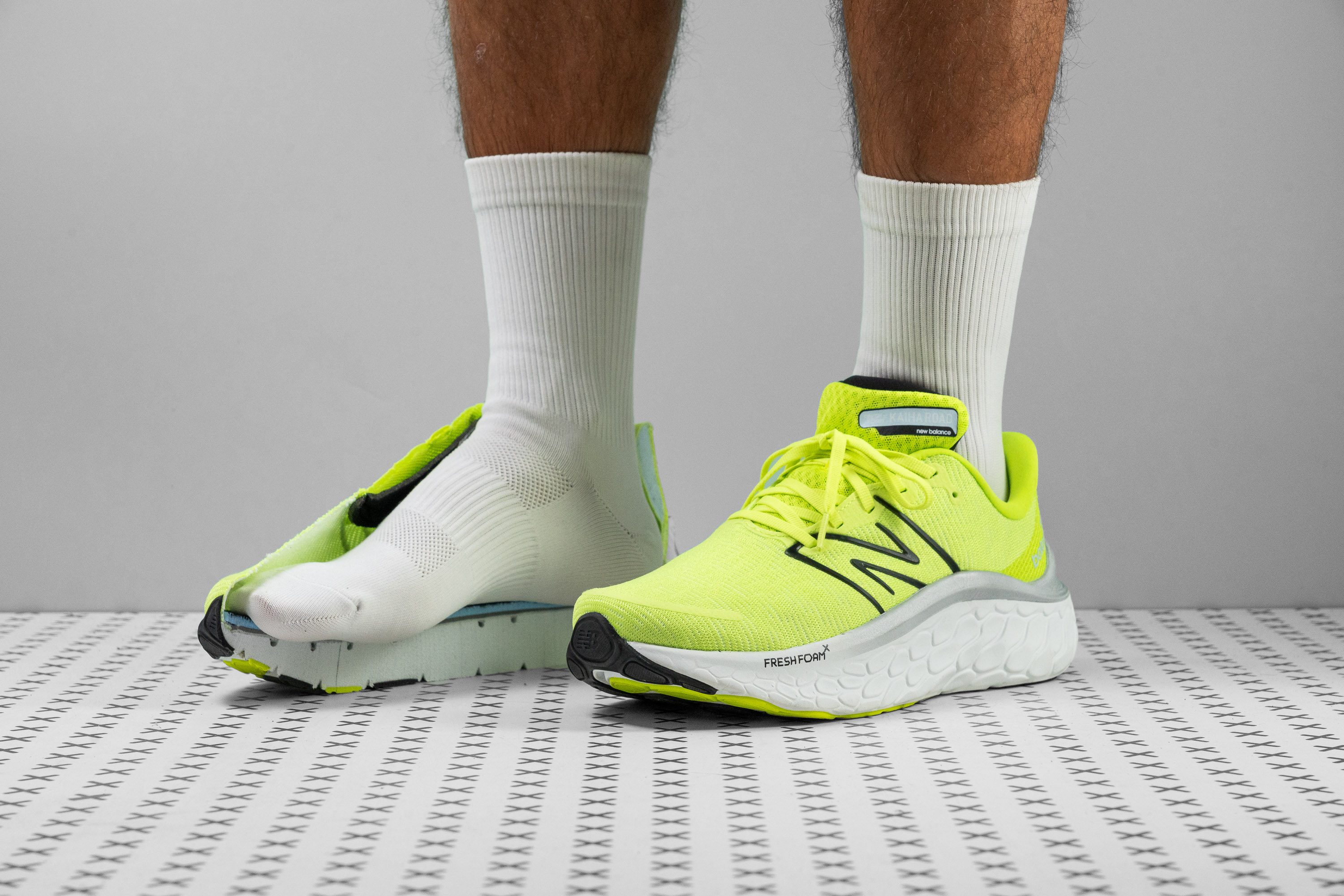











































What makes it the best?
During our runs with the Kaiha Road, comfort takes centre stage not only in terms of cushioning but also with its smooth transitions and forgiving ride. It has some springiness that makes the miles go by and offers a premium experience at an accessible price point. At £90, it’s cheaper than the £140 average New Balance road running shoe in our lab, making it our best budget pick from the brand’s cushioned roster.
The highlight of Kaiha Road is already featured in its name: the Fresh Foam X midsole. It completely erases ground impact with its tender touch and bouncy rebound. Our durometer confirms it’s 36.4% softer than average. Despite its plush nature, the ride feels amazingly stable due to Kaiha Road’s wide 119.2/100.1 mm base.
We find that it’s versatile enough for walks and other daily activities because of its fluid feel. Its rocker promotes forward momentum while the midsole adapts easily to our movements. Our bend test verifies it’s 10.8% more flexible than average.
However, while it can pick up the speed, it’s still not efficiently responsive to sustain faster paces for many miles. We recommend runners who want to break PBs to invest in more energetic shoes.
Pros
- Marshmallowy plush cushioning
- Great for recovery days
- Extremely flexible and forgiving
- Rockered midsole for smooth transitions
- Above average breathability
- Excellent performance in cold conditions
- Provides good stability
- Ideal for long runs
- Accommodating toebox
Cons
- Lacking in upper durability
- Needs some breaking in
- Needs some breaking in
Best cushioned New Balance running shoes for race
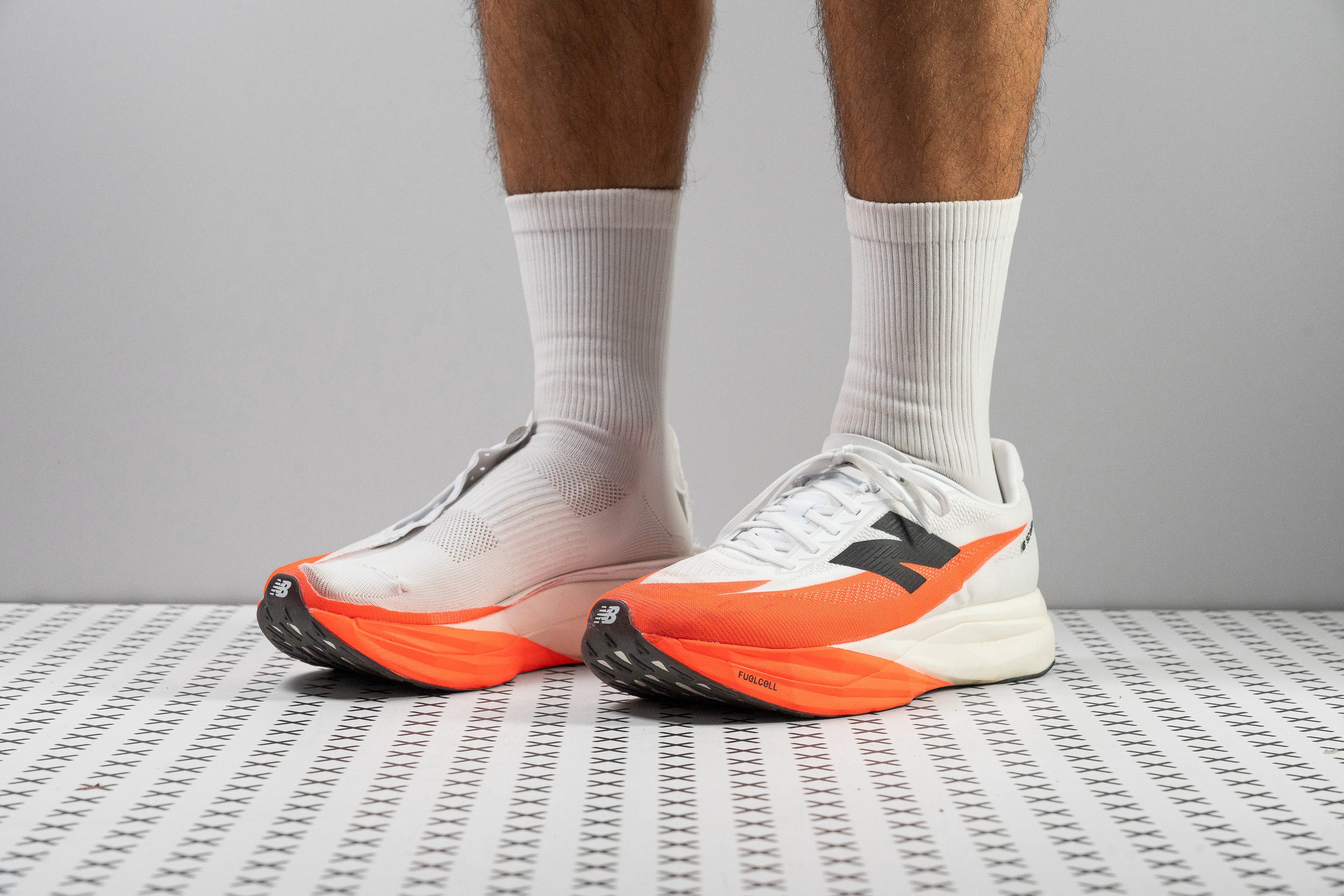
















































What makes it the best?
Our initial strides already confirm the FuelCell SuperComp Elite v5 is a deeply comfortable shoe, yet further testing in the lab validates it’s our top racer among New Balance cushioned running shoes. With a midsole so soft yet energetic, an outsole so grippy, and a build so minimal and refined, it’s hard to find a pair that matches its strong performance.
This shoe features both height and plushness, delivering maximum comfort even for long-distance racing. Our calliper reveals 39.3/28.6 mm measurements, much higher than the 34.8/26.1 mm lab average. The midsole is infused with softness and springiness, as our lab tests return a high 144 SA rating in our shock absorption test, and world-class energy return scores of 74.8% in the heel and 74.9% in the forefoot. This level of responsiveness translates to minimal loss of power during turnover.
Complementing the bouncy midsole is a curved carbon plate that features New Balance’s Energy ARC design. Underfoot, its power generation seems endless with its light 7.1 oz (198g) weight, enhancing our speed and efficiency.
The outsole displayed remarkable grip during testing, backed up by its solid 0.61 score in our traction test. It’s ready to stand ground in every race condition. Plus, it’s got more than enough thickness at 3.5 mm to cover occasional training sessions!
Just be careful not to slash the upper anywhere, as the material instantly surrendered in our Dremel test. Those who easily poke through shoes with their toes should think twice before purchasing this racer.
Pros
- Improved performance and speed
- Roomy toebox (for a competition shoe)
- Maxed-out heel stack
- Much lighter than before
- Strong grip from new outsole design
- Redesigned plate curvature for faster transitions
- Premium, breathable upper
- Fixes heel and tongue issues from v4
Cons
- Still not among the fastest supershoes
- Narrow heel reduces stability
- High drop may not suit everyone
- Comes without high-grip laces
Best cushioned New Balance stability running shoes
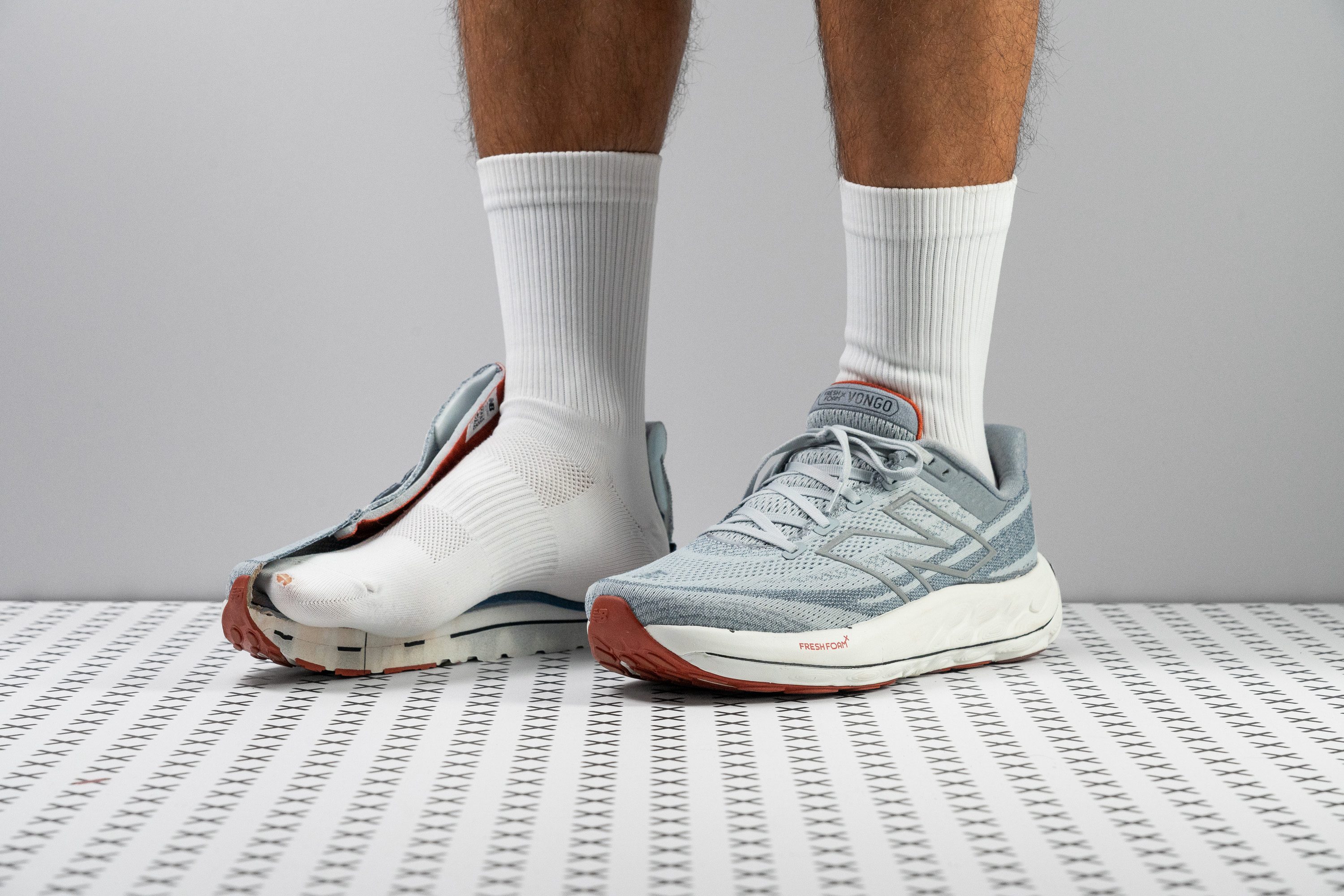






















































What makes it the best?
Rigorous lab assessments and lengthy runs brought us to the conclusion that the Fresh Foam X Vongo v6 is the best stability shoe among New Balance cushioned running shoes. This shoe has a unique way of supporting our foot alignment because it keeps the ride comfortable, smooth, and effortless.
The main stabiliser of the Vongo v6 is the combination of its dual-density midsole and plastic plate. The top layer measures a soft 15.8 HA for a plush feel, while the base is a more balanced 18.9 HA to enhance controlled landings. In between the two foams is an EVA film plate that is meant to secure our footing without adding rigidity to the shoe. True enough, Vongo v6 even emerged 20.3% more flexible than our lab average, which includes both stability and neutral shoes.
In addition to its natural feel, comfort is further enhanced by its generous 36.1/30.5 mm cushioning. This stack protects our muscles from landing impact, allowing us to run more miles as we please. However, this led to a heavy build of 11.0 oz (312g). Those who want speed and agility should find lighter pairs.
Pros
- Flexible design
- Comfortable, high-quality upper
- Exceptional durability
- Perfect for easy paces
- Also suitable for neutral runners
- Excellent for long runs
- Reasonably priced
Cons
- Noticeably heavy
- Limited breathability
- Not the best for heel strikers
Cushioned New Balance running shoes with the best energy return
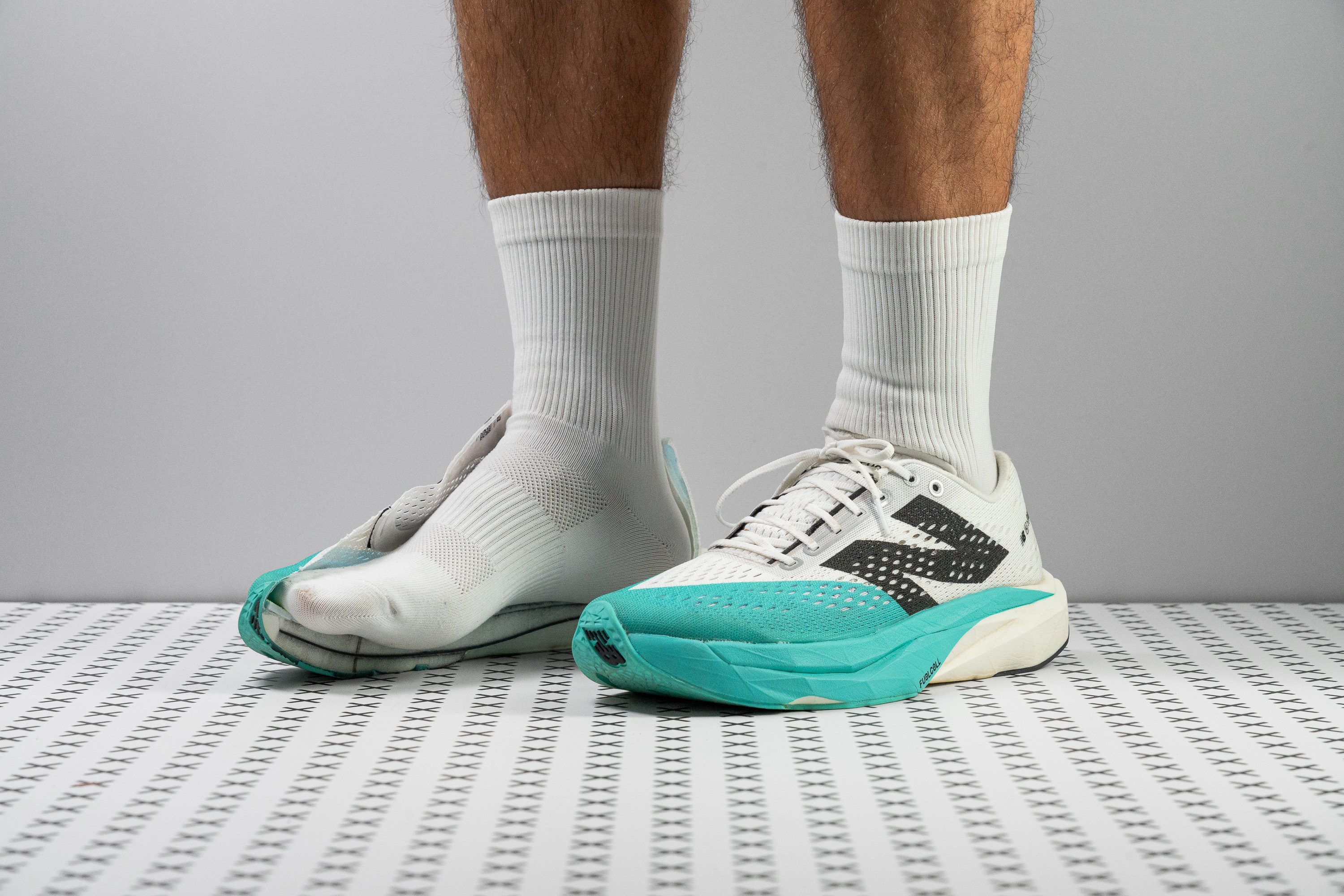




















































What makes it the best?
Despite its moderate stack height and minimal weight, the New Balance FuelCell SuperComp Pacer v2 packs tonnes of power and impact protection in its midsole. Our lab evaluations verify its impressive shock absorption, but ultimately, it stands out with its skyrocketing energy return scores among New Balance cushioned running shoes.
We went straight away to confirming the FuelCell midsole’s explosive feel, and the results back us up with strong energy return levels of 75.2% in the heel and 75.8% in the forefoot. At this level, it’s on par with many other supershoes!
We measured the stack height at a modest 32.9/25.4 mm, which is refreshing considering most racers edge closer to 40.0 mm. Despite having less foam beneath our feet, we still experienced a highly-cushioned feel because of its impressive shock absorption scores of 132/97 SA.
Because this shoe maintains a lower profile, it’s lightweight at 7.1 oz (200g). For reference, that’s 24.5% below average, enhancing both speed and comfort.
However, what’s uncomfortable is the curved design of the heel that digs into the skin. We recommend covering the Achilles tendon area or wearing thick socks to prevent rubbing and blistering.
Pros
- Diseñadas para volar en carreras de 5K/10K y medio maratón
- Ideales para corredores ligeros
- Más baratas que la mayoría de las superzapatillas
- Upper muy transpirable
- Destacan en entrenamientos de intervalos
- Han mejorado en comparación con sus predecesoras
- Perfectas para los amantes de las clásicas voladoras
- Espuma PEBA mullida y con rebote
Cons
- Teniendo en cuenta la altura de su suela, deberían ser más ligeras
- Puede que te rocen en el tendón de Aquiles
- Talón inestable
- Lengüeta corta y sin refuerzo
In this guide, we focus on cushioned running shoes from New Balance. That means that we cover the shoes with at least 30mm at the heel. If you want to learn more about New Balance running shoes in general, we recommend reading our guide Best New Balance running shoes.
7 things to consider when buying cushioned running shoes from New Balance
Cushioning is great and many runners opt for very cushioned running shoes. If you’re one of those runners, here’s what we recommend paying attention to:
- Softness and shock absorption. While softer often means more comfortable, some runners find firmer shoes more stable.
- How responsive the cushioning is. More energy return is always better! But, it depends on your needs and your budget.
- How high off the ground you want to be. More cushioning means more impact protection but it can also mean heavier shoes, different heel drops, and potentially unstable platforms.
- Is the platform stable? Higher platforms, especially in tempo and race shoes, can be quite wobbly.
- Is the weight of the shoe heavily impacted by the amount of cushioning? Is it too heavy?
- How stiff is the shoe? In premium high-stacked shoes, foams are often stiffened up with the carbon plates which makes them very stiff.
- Does the foam stay equally (or close-to-equally) soft in cold weather? If you plan to run in such weather, of course.
We will cover each feature separately now.
Shock absorption and softness of cushioned New Balance running shoes
The majority of runners prefer cushioned running shoes. This heavily depends on the experience and personal preferences, because running in less cushioned shoes and especially minimalist running shoes asks for a transition period, experience, and motivation.
Cushioning can be soft, firm, and everything in between. To measure this, we cut the shoes in half and then stick the HA durometer needle into the foam. When there are 2 foams (dual-density midsoles), we measure the softness of both foams.
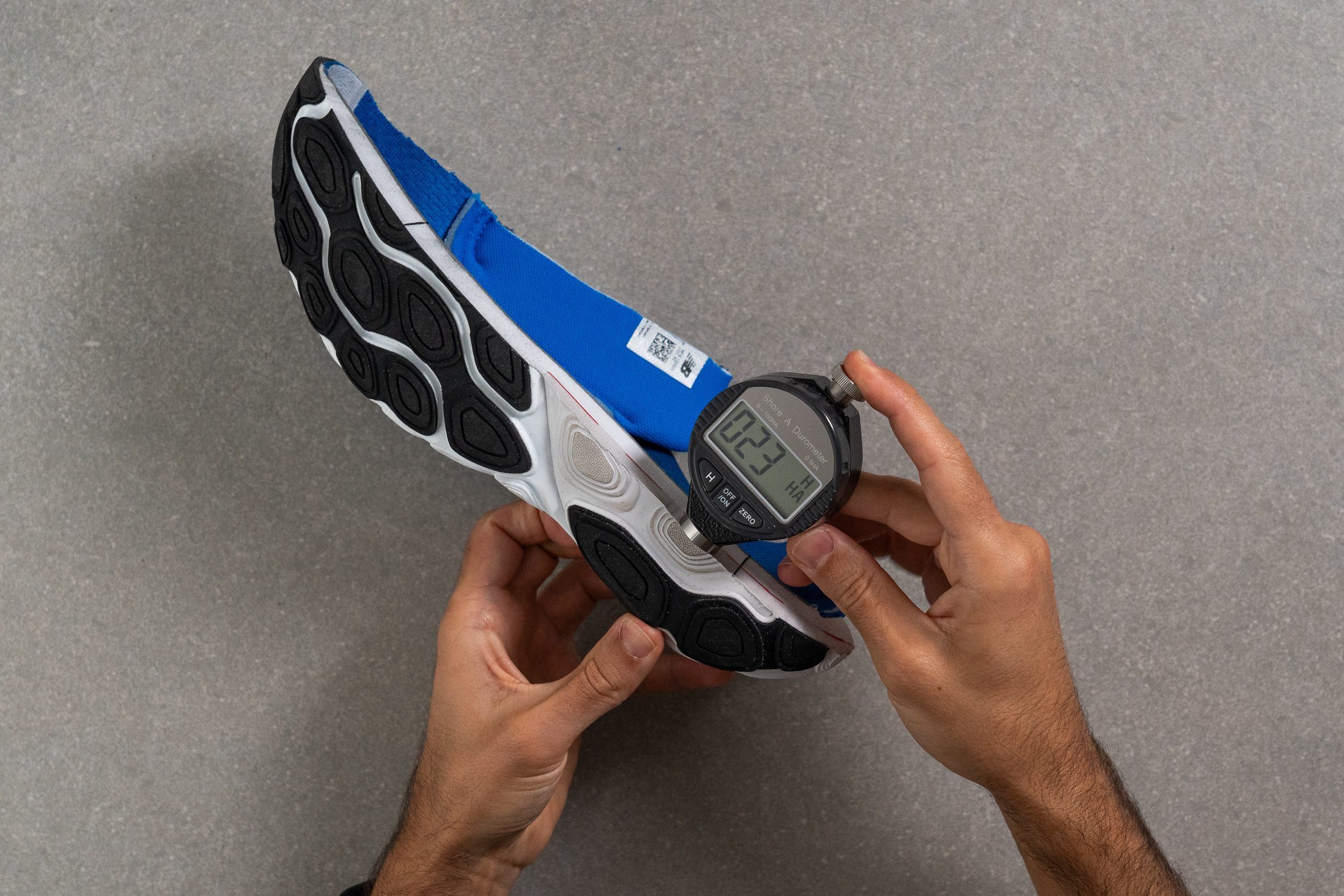
Lower numbers on the durometer tell us it’s a soft foam, while higher numbers indicate it’s a firmer foam. We usually associate soft foams with more impact protection and comfort, but firm foams feel more stable and supportive.
However, softness does not tell the whole story. Shock absorption actually plays a significant role. It tells us just how good the midsole is at dampening the impact at the landing. Running shoes with higher shock absorption lower the amount of stress sent to the legs, so obviously, it's better when it's a higher number. Keep in mind that, for daily trainers, beginners, and occasional runners, even moderate (average) shock absorption is a solid choice.
Energy return of cushioned New Balance running shoes
Energy return, pep, responsiveness, trampoline effect - however you call it, we all want it. This feature totally depends on the foam. The general rule is: premium foams offer an incredible energy return, although at a high price and they don’t last long, while standard foams tend to be less responsive but more durable and affordable.
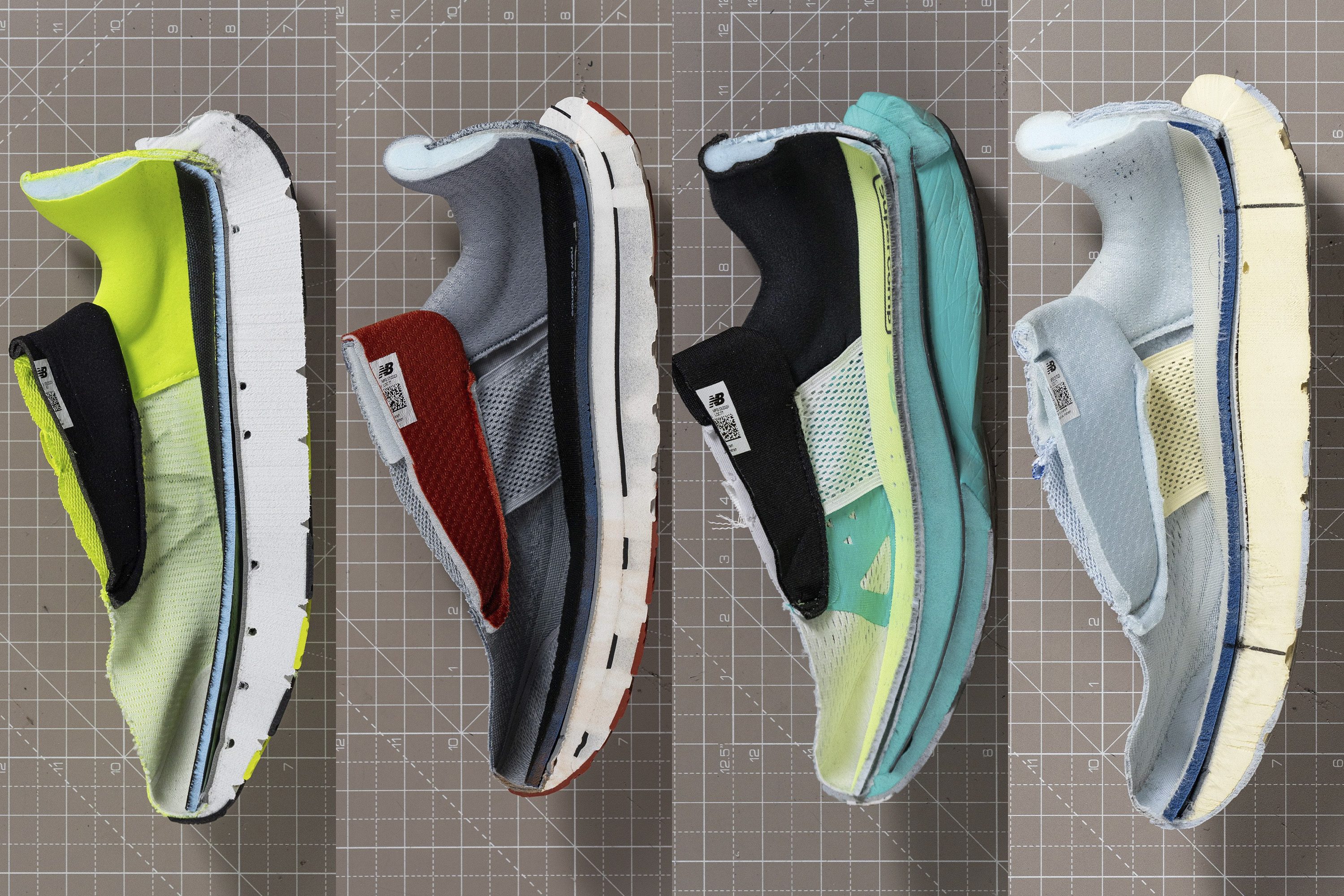
|
New Balance foam |
Foam type |
Main advantage |
Main drawback |
Our pick |
|
FuelCell (Pebax) |
Premium |
Softness |
Weight |
|
|
FuelCell (TPU / EVA) |
Standard |
Cloud-like feel |
Stability |
|
|
Fresh Foam / Fresh Foam X (EVA / EVA + PEBA) |
Standard |
Softness |
Mushy |
For more details about foams, we recommend you read our Ultimate guide to running shoe foams.
When it comes to testing the energy return, we test it at the same time as shock absorption (see the chapter above). The result is given in % and tells us how effective the midsole is in bouncing back after being landed on. The higher the energy return, the less our feet have to work in that moment, which results in so-called leg-saving features. Premium foams are known for it.
Stack height of cushioned NB shoes
The heel stack of cushioned running shoes starts at 30mm. The upper limit is not set in stone as brands try to make the shoes higher, especially in the competitive world. WorldAthletics has set a limit of 40mm at the heel for official races, and running in shoes higher than that can get you disqualified.
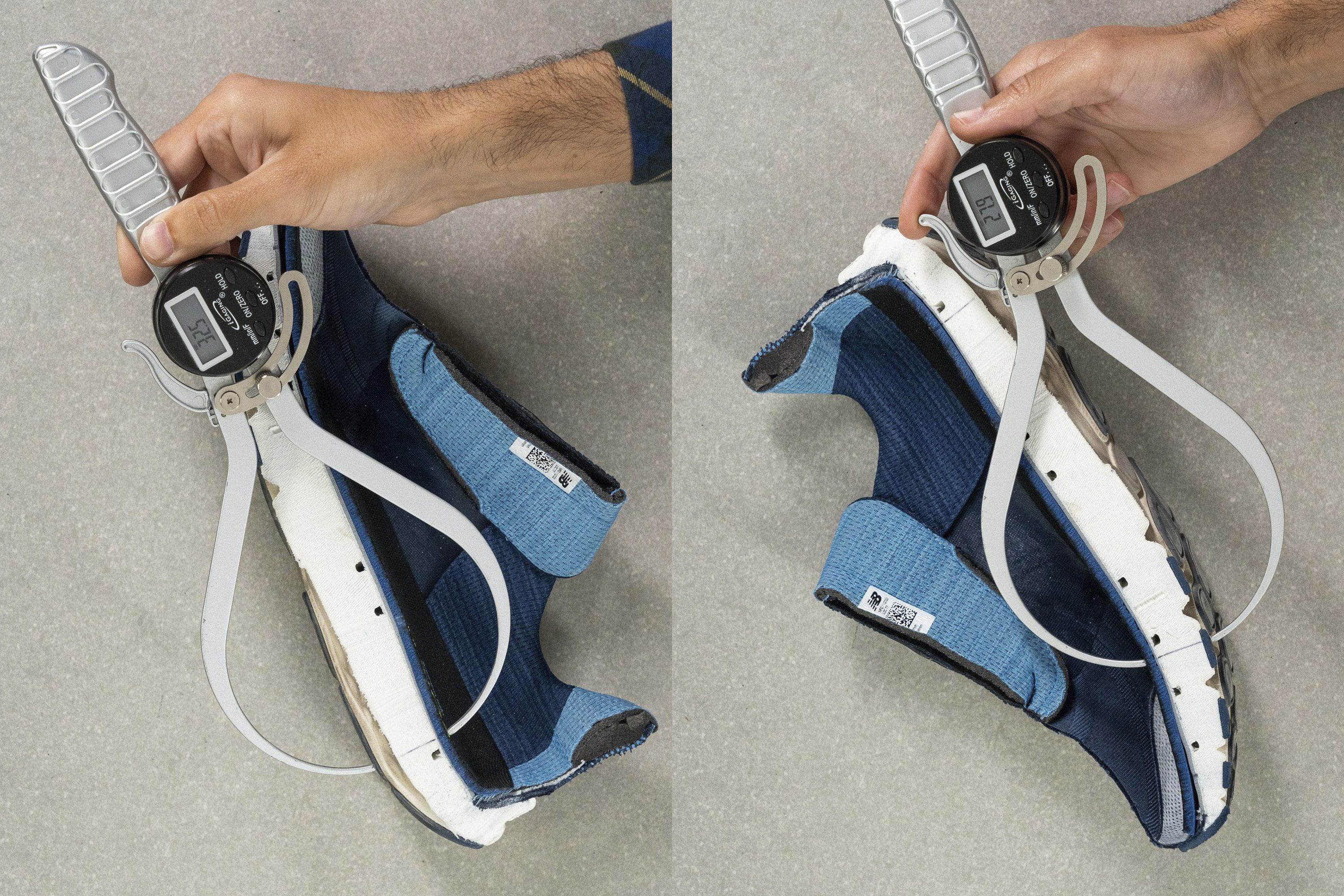
Of course, if you’re a heel striker, you should focus on the heel stack height. If you land on the forefoot/midfoot, you should check whether you have enough cushioning at the forefoot. In case you’re not sure about your foot strike, we covered that topic as well in our Ultimate guide on foot strike.
How to find stable running shoes
In cushioned running shoes, we notice a few things that influence their stability:
- The softness of the foam. When the foam is very soft and the platform high, the midsole can become very unstable (wobbly due to the foam getting squished easily).
- Width of the platform. When midsoles are high and narrow, they tend to be laterally unstable. We should look for wider platforms to avoid this.
- What goes into the midsole: a soft foam on its own, or it’s given some stability by embedding a plate (nylon or carbon-fibre) into the midsole.
To look for stable New Balance cushioned running shoes, it’s best to look at their platform. The wider the platform, the more stable the shoes!
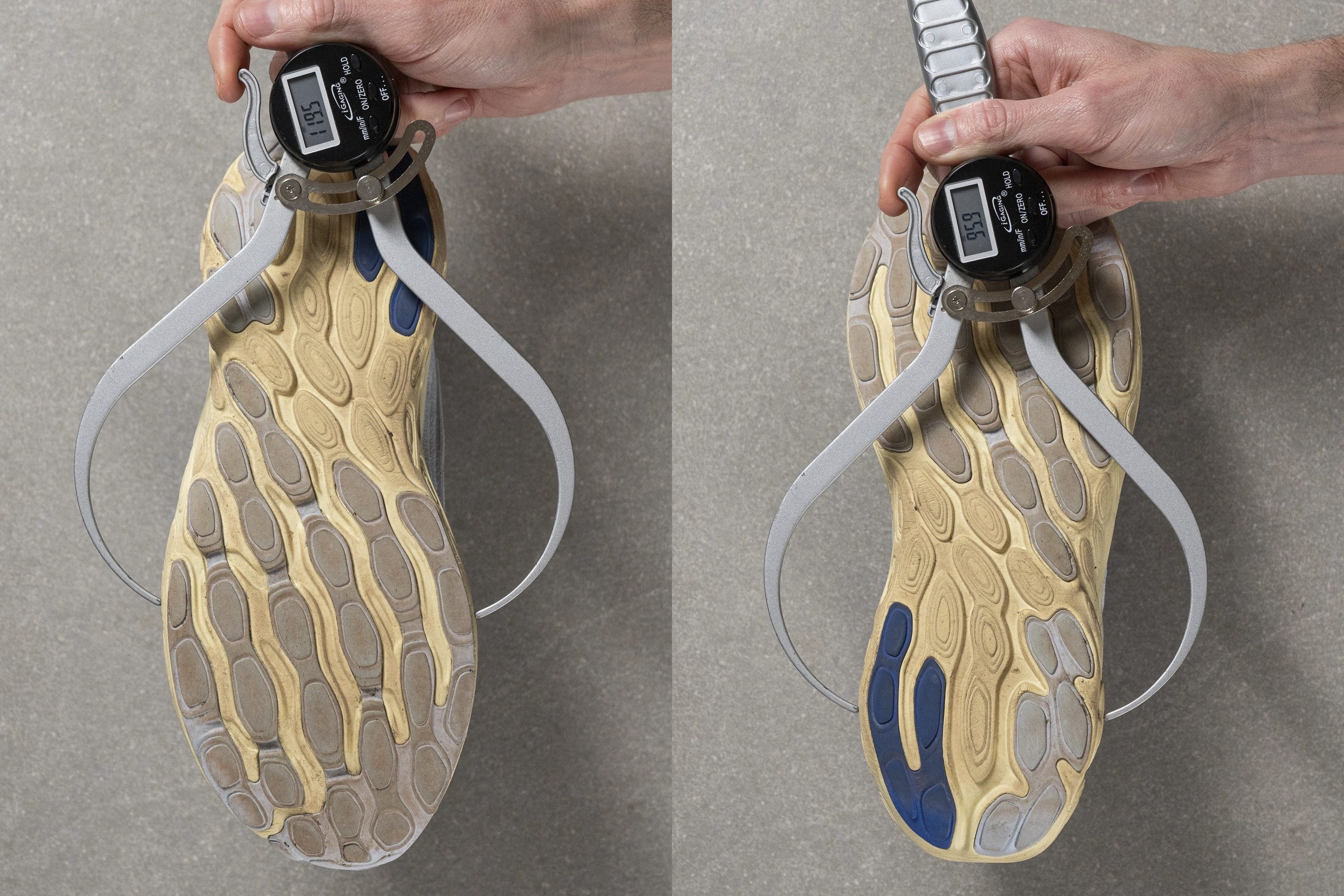
Again, if you land on the heel, it’s best that you focus on more width at the heel. If you’re a forefoot striker, look for more width there, although it’s the heel that causes the instability in most cases.
More cushioning = more weight?
When doing tempo runs and especially when racing, we prioritise lightweight and featherlight running shoes. This is because heavier shoes slow us down. In daily trainers, we sacrifice this for other features like padding, durability, and lower price.
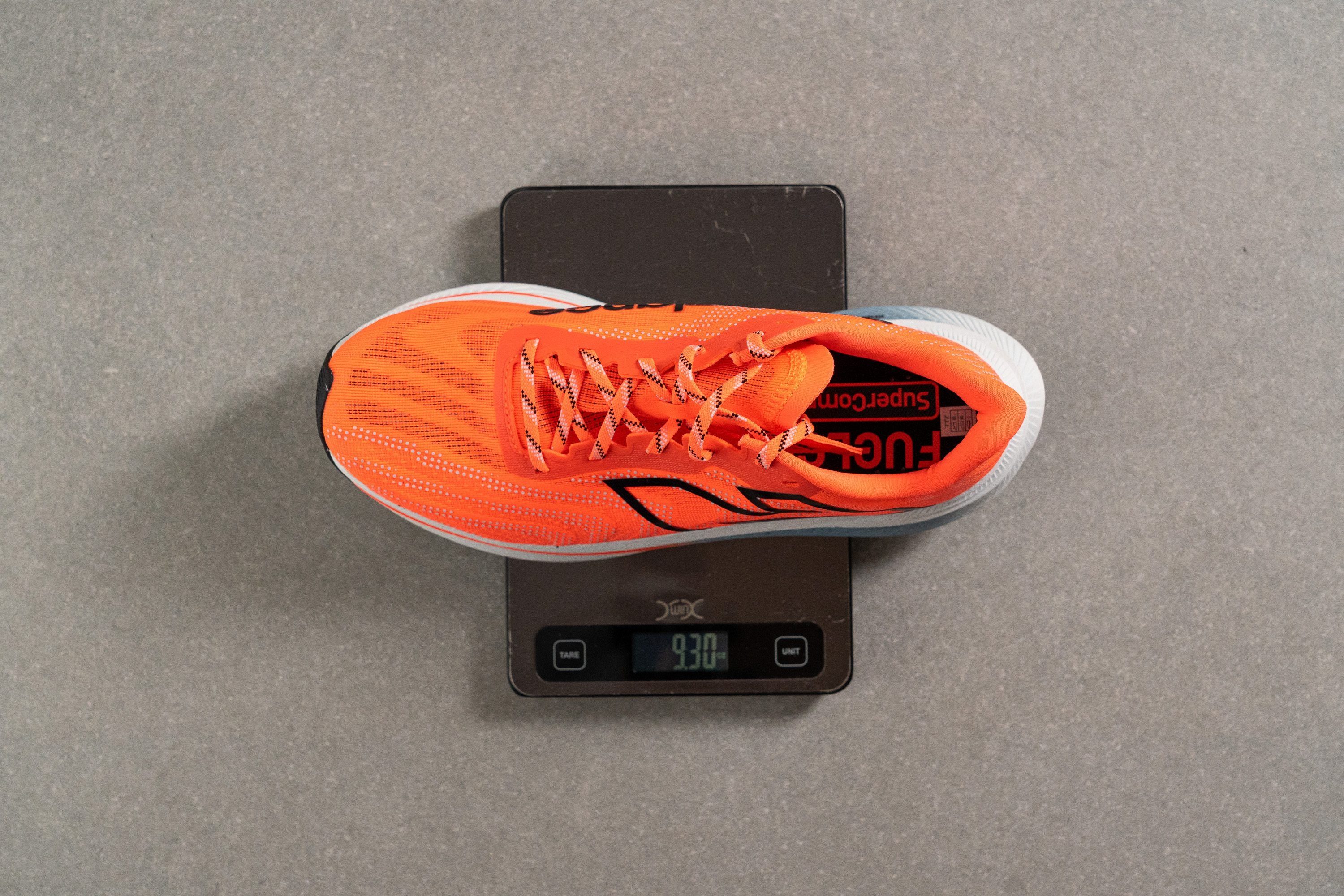
One would think that higher stack means more weight, however, we can see that some competition running shoes equipped with premium foams tend to be lightweight! It’s important to find a shoe that will not weigh you down. For some, that’s 200g, for others 250g. It’s best to try it on and experience its weight.
Flexible or stiff cushioned New Balance running shoes
Runners who prefer flexible running shoes do so because they appreciate the natural feel of the movement. Our feet are naturally flexible, so they expect the shoes to follow that. On the opposite end, we have runners who want the shoes stiff. Stiffness helps fight premature fatigue, and it brings stability to the platform and the overall ride.
There’s no right and wrong here, it’s on you to decide what you actually prefer and need. It’s worth noting that the stiffest shoes are carbon-plated race shoes.
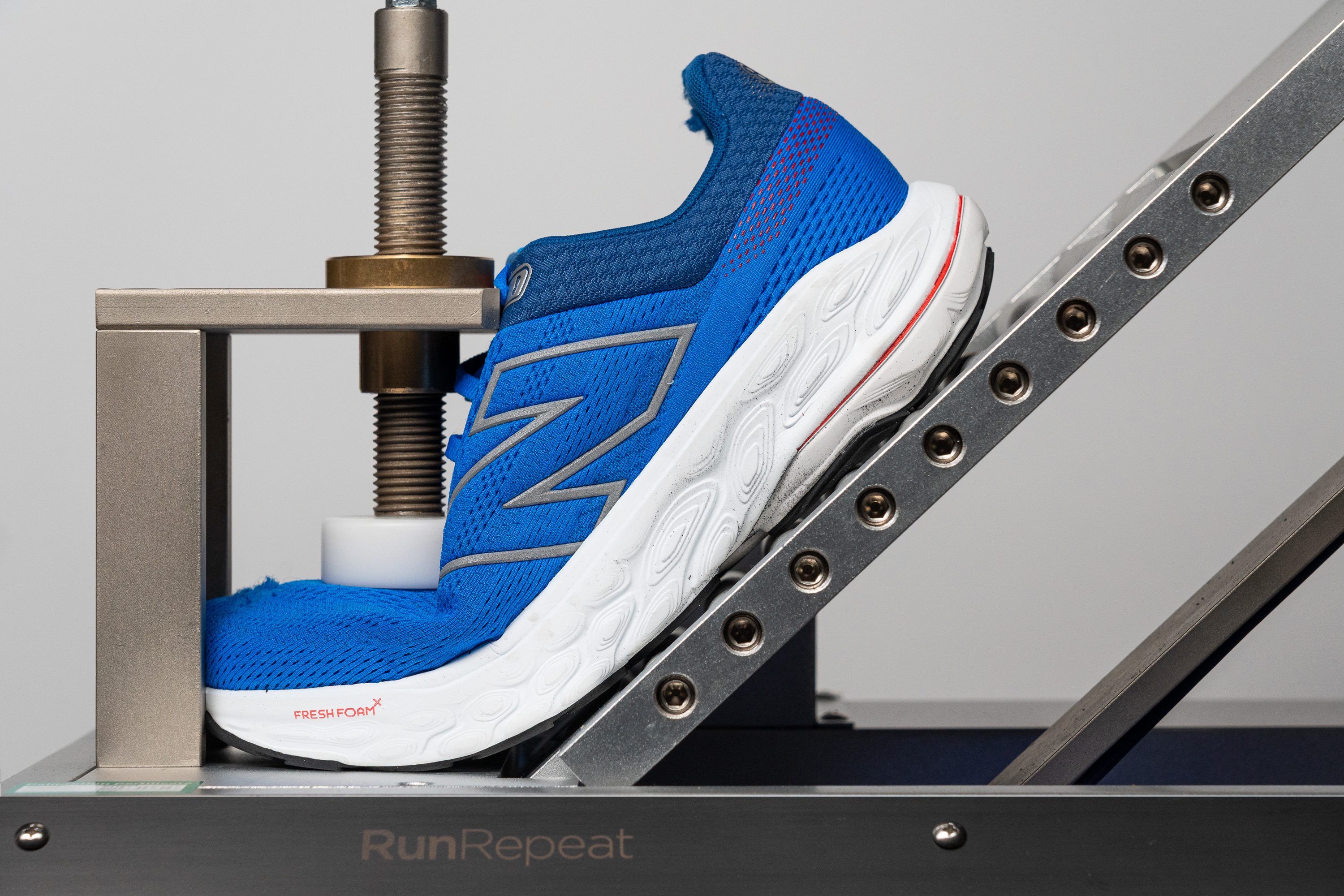
In our lab, we measure the stiffness of the shoes using a machine. We lock the toebox in place which makes the heel lift from the ground due to a toe rocker. We adjust the position of the bottom plate so that the heel rests on it. And then, we push the heel to a 30-degree angle and measure how much force was needed for that action. More force needed means stiffer shoes!
Cold weather: performance of NB cushioning
If you plan to run in cold weather or you simply live in a colder climate, knowing how the shoes feel at such temperatures is very important. Testers usually measure the softness of the foam at room temperature (so do we). But, we also put the shoes in the freezer to simulate cold weather and measure the change in softness.
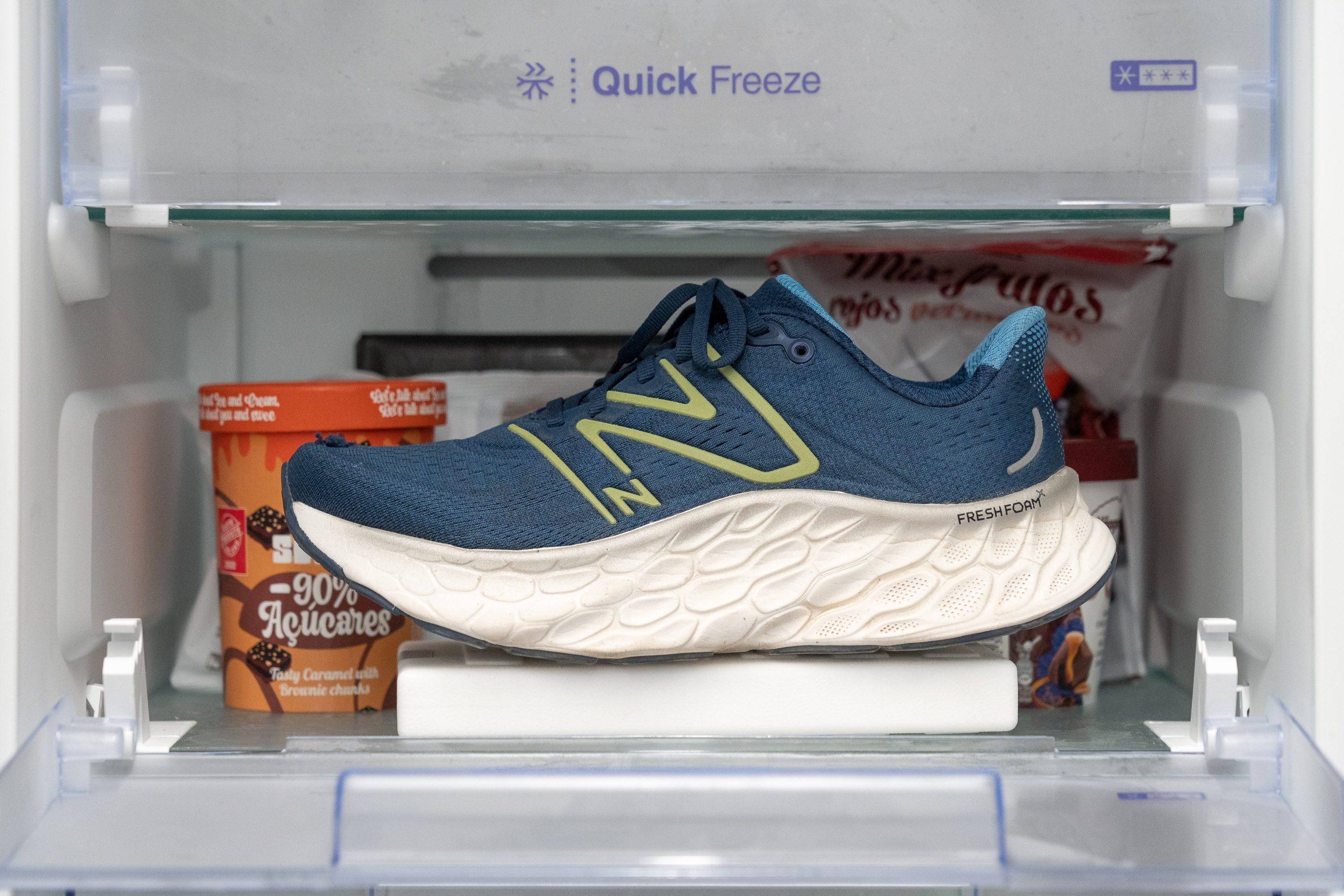
We use a shore A durometer to measure the softness of the foam. To do this, we cut the shoes in half and stick the durometer needle into the foam where the shoe was cut in half. Doing it any other way (like, from the outside, on a whole shoe) undeniably leads to very inaccurate and misleading measurements!
| We measure the softness a) at the room temperature and then b) after the shoe has spent 20mins in the freezer. The change in softness tells us how differently the shoe will feel in cold weather. |
However, it’s important to put those numbers into context. If a shoe starts at being very soft (say at 15 HA) and firms up 20%, it will still be rather soft. On the other hand, shoes that start at 30HA and firm up 80% will definitely lead to a noticeably firmer feel.
Insoles: thick, thin, or replaceable?
If you’re prioritising cushioning above anything else, you will also check out the insole. And, if you don’t like it, you’ll most likely swap it for a thick and soft one.
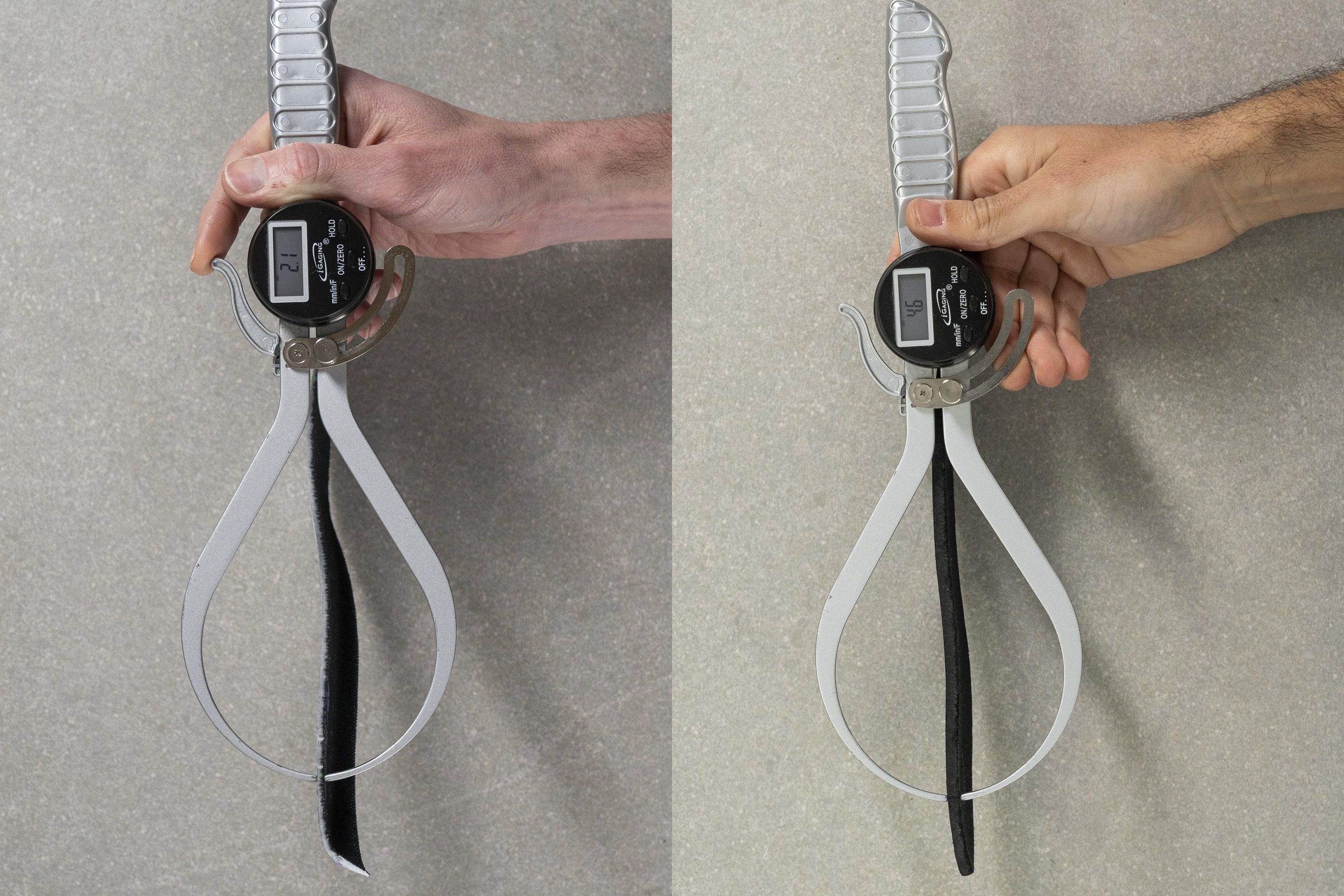
To educate you in advance, we measure the insole thickness in all shoes we test. We also note whether the insole is removable or glued to the bottom (so strongly that ripping it off would destroy the shoe to some extent).
Cushioned, padded, and/or plush New Balance running shoes
There’s a lot of confusion between these 3 terms, so we can offer a quick overview:
|
Category |
Heel stack |
Softness level |
|
Cushioned |
30mm+ |
any |
|
Soft |
any |
< 20 HA |
|
Plush |
high-stacked |
< 16 HA |
|
Padded |
any |
any |
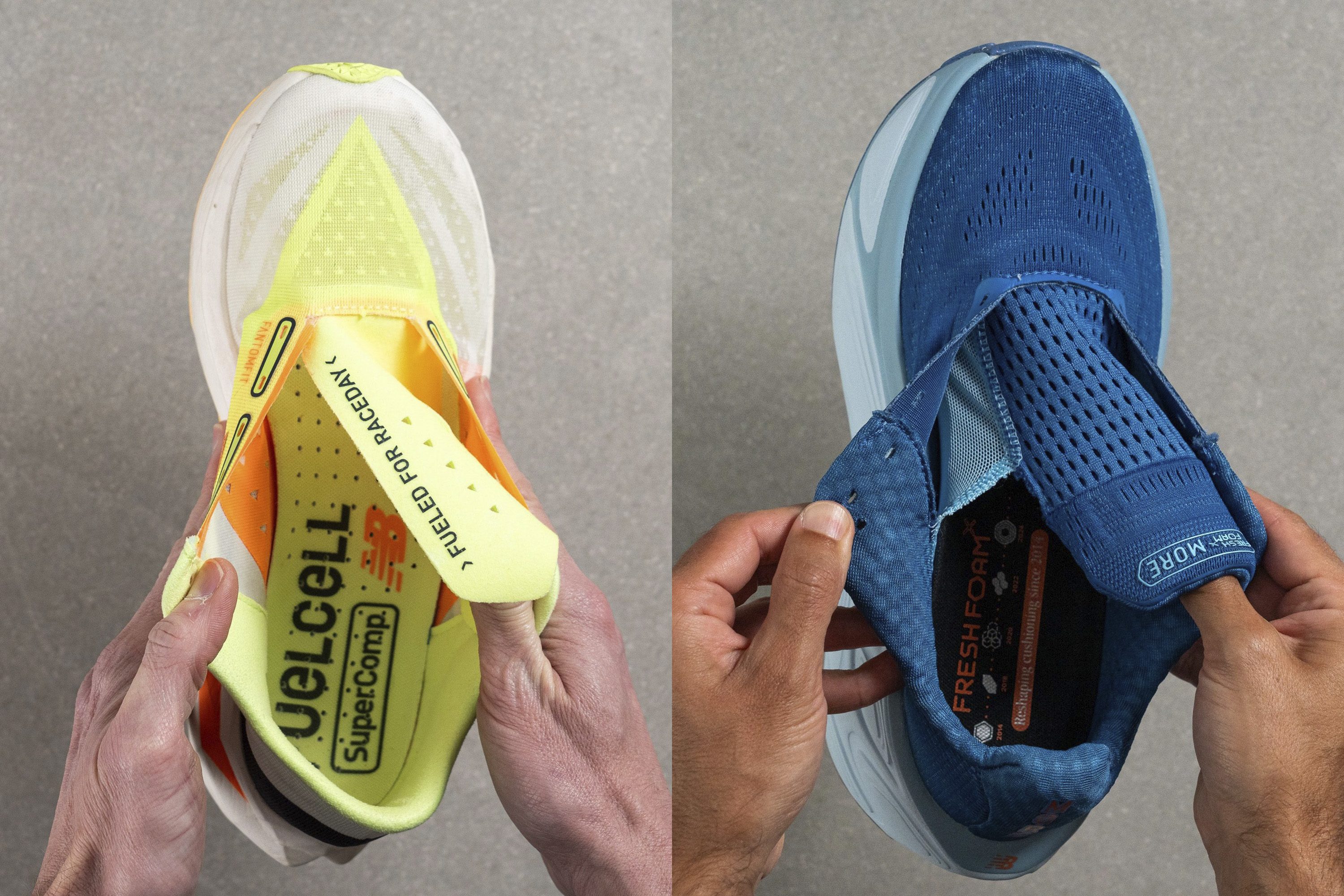 Very thin tongue and thinner heel padding (left) vs. a very padded heel and tongue (right)
Very thin tongue and thinner heel padding (left) vs. a very padded heel and tongue (right)

